
Mentha, also known as mint, is a genus of flowering plants in the family Lamiaceae. It is estimated that 13 to 24 species exist, but the exact distinction between species is unclear. Hybridization occurs naturally where some species' ranges overlap. Many hybrids and cultivars are known.

Spearmint, scientific name Mentha spicata, also known as garden mint, common mint, lamb mint and mackerel mint, is native to Europe and southern temperate Asia, extending from Ireland in the west to southern China in the east. It is naturalized in many other temperate parts of the world, including northern and southern Africa, North America, and South America. It is used as a flavouring in food and herbal teas. The aromatic oil, called oil of spearmint, is also used as a flavoring and sometimes as a scent.
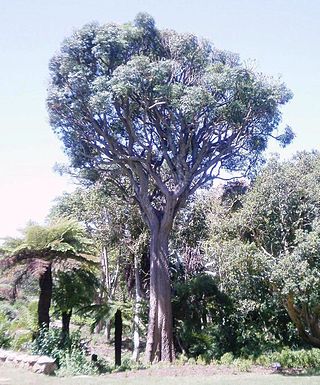
Cussonia spicata, known as spiked cabbage tree, lowveld cabbage tree or common cabbage tree, is a tree in the family Araliaceae, which is native to the moister regions of Sub-Saharan Africa. It is cultivated as a garden plant in areas without extreme degrees of frost. It is one of the favorite foods of wild elephants.

Pseudoroegneria spicata is a species of perennial bunchgrass known by the common name bluebunch wheatgrass. It is native to western North America.
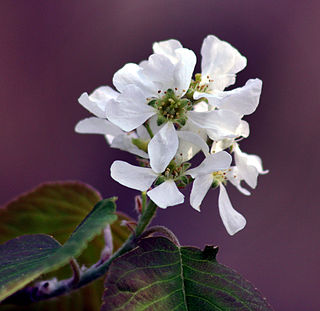
Amelanchier × spicata, also referred to as the low juneberry, thicket shadbush, dwarf serviceberry, or low serviceberry, is a hybrid of Amelanchier alnifolia × Amelanchier humilis. that has edible fruit, which are really pomes. They can be eaten raw or cooked. Amelanchier × spicata has clusters of small white flowers that bloom in spring.

Lomandra longifolia, commonly known as spiny-head mat-rush, spiky-headed mat-rush or basket grass, is a perennial, rhizomatous herb found throughout eastern Australia. The leaves are 40 cm to 80 cm long, and generally have a leaf of about 8 mm to 12 mm wide. It grows in a variety of soil types and is frost, heat and drought tolerant. Labillardiere described Lomandra longifolia from a specimen collected in Tasmania.
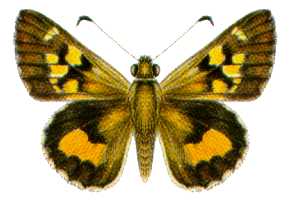
Trapezites phigalia, commonly known as the heath ochre or phigalia skipper, is a species of butterfly in the family Hesperiidae. It is endemic to Australia, where it occurs in New South Wales, Queensland, South Australia and Victoria. It is primarily found in eucalypt woodlands, open forests, and coastal healthland habitats.

Trapezites symmomus is a butterfly of the family Hesperiidae. It is found in Queensland, Victoria, South Australia and New South Wales.
Trapezites praxedes, commonly known as the southern silver ochre or praxedes skipper, is a species of butterfly in the family Hesperiidae. It is endemic to Australia, where it occurs in New South Wales, Queensland and Victoria.
Trapezites genevieveae, the ornate ochre skipper, is a butterfly of the family Hesperiidae. It is found in Australia along the coast of New South Wales and Queensland.

Lomandra obliqua, known as fish bones and twisted mat-rush, is a small wiry ground-covering flowering plant found in eastern Australia. It is a widespread plant seen on the coast and tablelands. The foliage superficially resembles a fern, but creamy/yellow flowers form on clusters in spring. Leaves are two-ranked, somewhat glaucous and twisted.

Lomandra confertifolia is a species of perennial herbs in the genus Lomandra, Asparagaceae, subfamily Lomandroideae. It is native to Queensland, Australia. Although it appears grass-like, it is not in the grass family.

Lomandra gracilis is a perennial, rhizomatous herb found in New South Wales and Queensland in eastern Australia.

Lomandra filiformis, commonly known as wattle mat-rush, is a tussock forming perennial herb that is native to Australia. It is sparsely tufted, with strap-like leaves and yellow flowers. It grows in dry sclerophyll forest and grassy woodland, usually on well-drained rocky or sandy soils.
Lomandra montana is a perennial, rhizomatous herb found in eastern Australia.
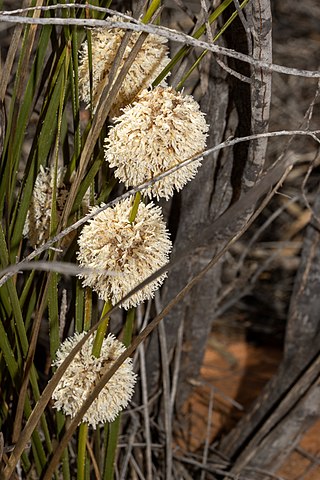
Lomandra leucocephala is a perennial, rhizomatous herb found in Australia. The plant is sometimes referred to as Irongrass because the plant is known to be tough and has a grass-like look.
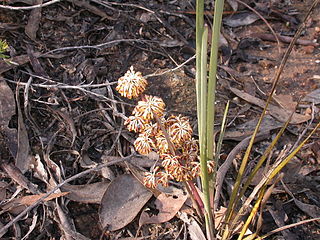
Lomandra multiflora, also commonly known as many-flowered mat rush, mat rush and many flowered mat-lily, is a perennial, rhizomatous herb found in Australia and Papua New Guinea. The mat rush is distributed widely in the region and common within its preferred growing conditions. Its conservation status is considered not to be of concern and risk.
Lomandra glauca is a perennial, rhizomatous herb found in Australia.

Indigofera spicata, the creeping indigo or trailing indigo, is a species of flowering plant in the family Fabaceae. It is native to Sub‑Saharan Africa, Madagascar, Mauritius, Réunion, and Yemen, and has been introduced to the southeastern United States, various Caribbean islands, Brazil and other locations in Latin America, various Pacific islands, and New South Wales and Queensland in Australia. It was considered to be a promising forage plant, and then shown to be toxic to nearly all livestock, but it is possible that the experiments were conducted on the similar Indigofera hendecaphylla, leading to some confusion.

Lomandra bracteata is a species of plant in the Asparagaceae family, first described in 1962 by Alma Theodora Lee.
















